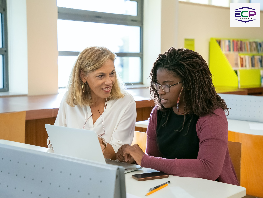
Live Classes
Live classes, also known as online or virtual classes, are real-time educational sessions conducted over the internet. In a live class, students and teachers interact in a virtual environment, allowing for instant communication, discussions, and engagement. These classes mimic the traditional classroom setting but take place in the digital realm.
Importance of Live Classes:
- Real-Time Interaction:
- Live classes facilitate direct interaction between students and instructors. Questions can be asked and answered instantly, fostering a dynamic and responsive learning environment.
- Engagement and Active Participation:
- Through polls, quizzes, and discussions, live classes encourage active participation. Students can engage with the material, respond to queries, and collaborate with peers in real-time.
- Immediate Clarification:
- Misunderstandings or confusion about a topic can be addressed immediately. Instructors can provide clarifications on complex concepts, ensuring that students grasp the content accurately.
- Structured Learning Experience:
- Live classes follow a structured schedule and curriculum. This ensures that all essential topics are covered systematically, helping students stay organized in their learning journey.
- Flexibility with Scheduled Timings:
- While live classes have scheduled timings, they offer flexibility. Students can attend classes from any location with an internet connection, providing convenience without compromising on engagement.
- Recording Option:
- Many live classes are recorded, allowing students to revisit sessions at their convenience. This feature is beneficial for those who may miss a class or want to review the material for better understanding.
- Personalized Attention:
- Live classes often maintain a controlled student-teacher ratio, allowing for personalized attention. Instructors can address individual queries and provide tailored guidance to students.
- Technology-Enhanced Learning:
- Live leverage various technological tools, including multimedia presentations, interactive whiteboards, and collaborative platforms. This enhances the learning experience by integrating modern educational technologies.
- Building a Learning Community:
- Students can connect with each other in real-time, fostering a sense of community. Group discussions, teamwork, and shared learning experiences contribute to a collaborative and supportive atmosphere.
- Feedback and Assessment:
- Instructors can provide immediate feedback on assignments, quizzes, or assessments conducted during live classes. This timely feedback helps students track their progress and areas for improvement.
Live classes offer a blend of traditional teaching methods with modern technology, creating an engaging and effective learning experience. They have become increasingly popular due to their flexibility, accessibility, and the ability to cater to diverse learning styles. As education evolves, live classes continue to play a pivotal role in shaping the future of learning.

CA FOUNDATION
CA Foundation is the entrance level for the Chartered Accountancy course in India which is offered by ICAI . Earlier it was known as Common Proficiency Test (CPT)……….
CA INTERMEDIATE
CA Intermediate is the second level for Chartered Accountancy Course offered by the Institute of Chartered Accountants of India (ICAI).Students can register for CA inter…………
CMA FOUNDATION
CMA course is gaining immense popularity among commerce students, especially students who want to make it big in their career in the field of Cost and Management……
CMA INTERMEDIATE
CMA Intermediate is the Second Level exam for CMA Course in india which is offered by ICMAI, Students can register for CMA inter after qualifying CMA Foundation…….
CS EET
ICSI offers CS EET as the entrance exam for the Company Secretary Course. “ICSI previously called it the CS Foundation Programme. It is mandatory for all the candidates.
CS EXECUTIVE
CS Executive is Second Level of Company Secretary Course. Candidates can register for CS Executive Course throughout the year who have passed CSEET …..



